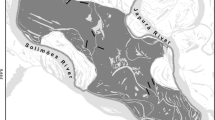Abstract
Results of a 10-month study of the ecology and behavior of free- ranging woolly spider monkeys (Brachyteles arachnoides)in Brazil show that these animals are strongly folivorous. Leaf-eating accounted for more than 50% of the total feeding time in all samples but one and accounted for more than 80% of the total feeding time in three samples. Mature foliage was routinely eaten. Woolly spider monkeys consistently spend more than 50% of each day quietly resting and sleeping. Animals travel little except when actively feeding and show low levels of social interaction. Such an activity profile suggests that woolly spider monkeys may often be living near the limits of their energetic resources. The social organization of the species is unusual for a folivorous primate in that small groups of females and associated immature animals confine their activities to discrete home-range areas, whereas males are itinerant, traveling over the home ranges of various female groups. Animals sharing a common home-range area show no permanent daily pattern of association other than that of mother-dependent offspring. Foraging alone or with few conspecifics should maximize each individual’s returns from foraging by minimizing the day range that must be traveled each day to locate foods while simultaneously lowering interference competition for higher-quality dietary resources.
Similar content being viewed by others
References
Aguirre, A. C. (1971). O MonoBrachyteles arachnoides, Academia Brasileira de CiÊncias como Contribuicào ao Programa Biologico International, Rio de Janeiro, pp. 1–53.
Bauchop, T. (1978). Digestion of leaves in vertebrate arboreal folivores. In Montgomery, G.G. (ed.),The Ecology of Arboreal Folivores, Columbia University Press, New York, pp. 193–204.
Bauchop, T., and Martucci, R. W. (1968). Ruminant-like digestion in the langur monkey.Science 161: 698–700.
Gaulin, S. J. C, and Gaulin, C. K. (1982). Behavioral ecology ofAlouatta seniculus in Andean cloud forest.Int. J. Primatol. 3: 1–52.
Glander, K. E. (1975).Habitai and Resource Utilization: An Ecological View of Social Organization in Mantled Howler Monkeys, Ph.D. dissertation, University of Chicago, Chicago.
Grand, T. I. (1978). Adaptation of tissue and limb segments to faciliate movement and feeding in arboreal folivores. In Montgomery, G.G. (ed.),The Ecology of Arboreal Folivores, Smithsonian Press, Washington, D.C., pp. 231–242.
Hill, W. C. O. (1962).Primates: Comparative Anatomy and Taxonomy, Vol. 4, Interscience, New York.
Johnson, J. E., and McBee, R. H. (1967). The porcupine cecal fermentation.J. Nutrition 91: 540–546.
Jolly, A. (1972).The Evolution of Primate Behavior, Chicago University Press, Chicago.
Kinsey, W. G. (1982). Distribution of some Neotropical primates and the model of Pleistocene forest refugia. In Prance, G. T. (ed.),Biological Diversification in the Tropics, Columbia University Press, New York, pp. 455–482.
Klein, L. L., and Klein, D. B. (1977). Feeding behaviour of the Colombian spider monkey. In Clutton-Brock, T. H. (ed.),Primate Ecology: Studies of Feeding and Ranging Behaviour in Lemurs, Monkeys and Apes, Academic Press, London, pp. 153–181.
McBee, R. H. (1978). Fermentation in the hindgut. In Clark, R., and Bauchop, T. (eds.),Microbial Ecology of the Gut, Academic Press, London, pp. 185–217.
McNab, B. K. (1978). Energetics of arboreal folivores: Physiological problems and ecological consequences of feeding on an ubiquitous food supply. In Montgomery, G. G. (ed.),The Ecology of Arboreal Folivores, Smithsonian Press, Washington, D.C., pp. 153–162.
Milton, K. (1979). Factors influencing leaf choice by howler monkeys: A test of some hypotheses of herbivore leaf choice.Am. Nat. 114: 362–378.
Milton, K. (1980).The Foraging Strategy of Howler Monkeys: A Study in Primate Economics, Columbia University Press, New York.
Milton, K. (1981a). Food choice and digestive strategies of two sympatric primate species.Am. Nat. 117: 476–495.
Milton, K. (1981b). Estimates of reproductive parameters for free-ranging rangingAteles geoffroyi.Primates 22: 574–579.
Milton, K. (1981c). Distribution patterns of tropical plant foods as an evolutionary stimulus to primate mental development.Amer. Anthrop. 85: 534–548.
Milton, K. (1984). The role of food processing factors in primate food choice. In Rodman, P., and Cant, J. (eds.),Adaptations for Foraging in Non-Human Primates, Columbia University Press, New York, pp. 249–279.
Milton, K. (1984). Urine washing behavior in the woolly spider monkey. 2.Tierpsychol., in press.
Milton, K., and May, M. L. (1976). Body weight, diet and home range in primates.Nature Lond. 259: 459–462.
Milton, K., and McBee, R. H. (1982). Structural carbohydrate digestion in a New World primate,Alouatta palliata.Comp. Biochem. Physiol. 74: 29–31.
Milton, K., Van Soest, P. J., and Robertson, J. (1980). Digestive efficiencies of wild howler monkeys.Physiol. Zool. 53: 402–409.
Parra, R. (1978). Comparison of foregut and hindgut fermentation in herbivores. In Montgomery, G. G. (ed.),The Ecology of Arboreal Folivores, Smithsonian Press, New York, pp. 205–230.
Prance, G. T., Rodrigues, W. A., and da Silva, M. F. (1976). Inventario florestal de um hectare de mata de terre firme km 30 da Estrade Manaus-Itacoatiara.Ada Amazon. 6: 9–35.
Rodman, P. S. (1984). Foraging and social systems of orangutans and chimpanzees. In Rodman, P. S., and Cant, J. (eds.),Adaptations for Foraging in Non-human Primates, Columbia University Press, New York, pp. 134–160.
Taylor, C. R., Caldwell, S. L., and Rountree, V. J. (1972). Running up and down hills: Some consequences of size.Science 178: 1096–1097.
Veja (1982). Vol. 708, p. 82.
Wrangham, R. W. (1977). Feeding behaviour of chimpanzees in Gombe National Park, Tanzania. In Clutton-Brock, T. H. (ed.),Primate Ecology: Studies of Feeding and Ranging Behaviour in Lemurs, Monkeys and Apes, Academic Press, London, pp. 504–538.
Zingeser, M. R. (1973). Dentition ofBrachyteles arachnoides with reference to Alouattine and Atelinine affinities.Folia primatol. 20: 351–390.
Author information
Authors and Affiliations
Rights and permissions
About this article
Cite this article
Milton, K. Habitat, diet, and activity patterns of free-ranging woolly spider monkeys (Brachyteles arachnoides E. Geoffroy 1806). Int J Primatol 5, 491–514 (1984). https://doi.org/10.1007/BF02692271
Received:
Revised:
Issue Date:
DOI: https://doi.org/10.1007/BF02692271




